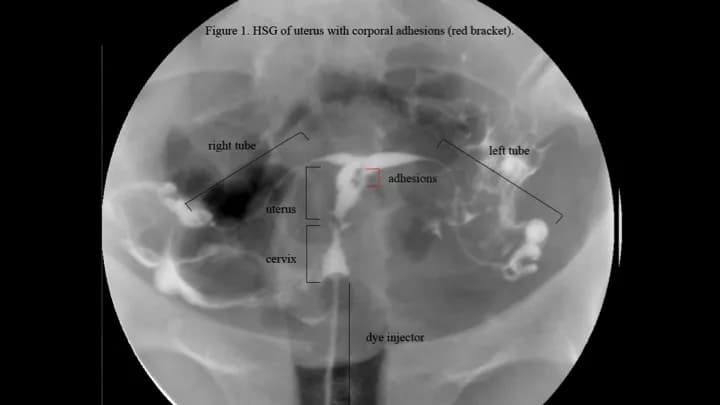What are the other Names for this Condition? (Also known as/Synonyms)
- Gynatresias
- Traumatic Amenorrhea due to Asherman Syndrome
- Uterine Synechiae due to Asherman Syndrome
What is Asherman Syndrome? (Definition/Background Information)
- Asherman Syndrome is a medical condition, where the walls of the uterus stick to one another, which is usually caused by several D&C (dilatation and curettage) procedures in a woman
- Due to this condition, women normally experience menstrual problems, such as reduced flow or a lack of menstrual flow, painful period, which can even lead to miscarriages and infertility
- Asherman Syndrome may be treated through surgical interventions - by surgically removing the adhesions. In many cases, the prognosis for Asherman Syndrome is generally good
Who gets Asherman Syndrome? (Age and Sex Distribution)
- Asherman Syndrome can occur in women of any age, especially after repeated D&C, or after any surgeries involving the uterus
- Individuals of all races and ethnic groups can be affected
What are the Risk Factors for Asherman Syndrome? (Predisposing Factors)
The risk factors of Asherman Syndrome could include:
- Congenital defects of the uterus, like septate uterus or bicornuate uterus, increase the risk for Asherman Syndrome
- Repeated miscarriages, leading to repeated D&C procedures
- Any uterine surgery
It is important to note that having a risk factor does not mean that one will get the condition. A risk factor increases ones chances of getting a condition compared to an individual without the risk factors. Some risk factors are more important than others.
Also, not having a risk factor does not mean that an individual will not get the condition. It is always important to discuss the effect of risk factors with your healthcare provider.
What are the Causes of Asherman Syndrome? (Etiology)
Any condition that damages the inner layers of the uterus can lead to Asherman Syndrome. Hence, the condition is also known as Traumatic Uterine Adhesions. The factors that may cause the condition include:
- Several dilatation and curettage (D&C) procedures, performed for various reasons
- Cesarean section
- Retained products of conception after delivery
- Infection of the uterus after delivery (postpartum endometritis)
- Infections like tuberculosis (called pelvic tuberculosis), schistosomiasis, etc.
What are the Signs and Symptoms of Asherman Syndrome?
The signs and symptoms of Asherman Syndrome may include:
- No menstrual flow (amenorrhea)
- Decreased menstrual flow (oligomenorrhea)
- Painful menses (dysmenorrhea)
- Infertility
- Recurrent miscarriages
How is Asherman Syndrome Diagnosed?
Asherman Syndrome is diagnosed by the following exams and tests:
- Physical examination with thorough medical history evaluation, which would include an examination of the genital area
- Blood tests to rule out infections, like tuberculosis or schistosomiasis
- Hysteroscopy: By this procedure the uterine cavity can be directly examined; the scar tissue may be observed
- Hysterosalpingogram (HSG): In this procedure, a dye is injected into the uterine cavity followed by x-rays, to look for any blockage
- Hysterosonogram: Fluid is injected into the uterine cavity and an ultrasound is simultaneously performed, to look for the presence of adhesions
- Transvaginal ultrasound: This is done to measure the thickness of the inner layers of the uterus
Many clinical conditions may have similar signs and symptoms. Your healthcare provider may perform additional tests to rule out other clinical conditions to arrive at a definitive diagnosis.
What are the possible Complications of Asherman Syndrome?
The most important complication of Asherman Syndrome is infertility.
How is Asherman Syndrome Treated?
The treatment of Asherman Syndrome is undertaken as follows:
- Asherman Syndrome can be treated through a surgical removal of the scar tissue, using hysteroscopy procedure (that is like an endoscopy of the uterus). In this procedure, the uterus is directly visualized and scar tissue removed
- Also a balloon is kept for few days inside the uterus, to prevent the uterine walls from sticking to one another
- If the disorder is caused by any infection, like tuberculosis or schistosomiasis, then antibiotics are prescribed
How can Asherman Syndrome be Prevented?
- There is no known method to prevent Asherman Syndrome
- But, the incidence of this condition may be reduced by avoiding repeated D&Cs, where possible
- Proper medical management of uterine conditions and associated surgeries can help decrease the incidence of Asherman Syndrome
What is the Prognosis of Asherman Syndrome? (Outcomes/Resolutions)
The prognosis of Asherman Syndrome is usually good after surgery, with most women having increased pregnancy rates.
Additional and Relevant Useful Information for Asherman Syndrome:
- A dilatation & curettage (D&C) procedure involves opening the cervix and surgically removing the inner lining and tissue present in the uterus
The following article link will help you understand the dilatation & curettage (D&C) of uterus surgical procedure.
http://www.dovemed.com/common-procedures/procedures-surgical/dilatation-curettage-of-the-uterus/
Related Articles
Test Your Knowledge
Asked by users
Related Centers
Related Specialties
Related Physicians
Related Procedures
Related Resources
Join DoveHubs
and connect with fellow professionals


0 Comments
Please log in to post a comment.